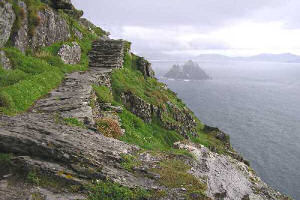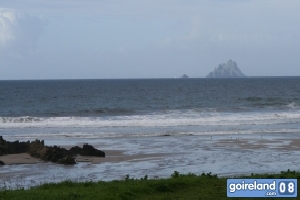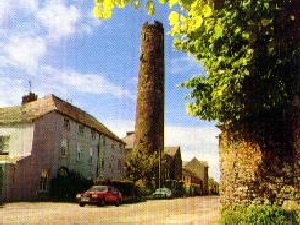Drawing from Ireland’s deeply spiritual past, here is a list of classic monasteries in Ireland that represent a classical age of piety.
Clonmacnoise Monastery 
Clonmacnois Monastery was founded in 548-49 by St. Ciaran, after abandoning his cell on Hare Island in Lough Ree. Dermot, a local prince, enlisted Ciaran’s prayers to get him elected High King. Dermot rewarded Ciaran by endowing the monastery. Ciaran died shortly afterwards, but Ciaran’s monastery prospered.
One interesting church in the monastery is the Nuns’ church which was erected, by Queen Devorgilla as a mark of repentance in 1167. In 1152, Devorgilla deserted her husband, Tiernan O’Rourke, while on pilgrimage to Lough Derg. To add insult to injury, she eloped with his worst enemy Diarmuid MacMurrouhg, bringing her animals and furniture with her. She returned to her husband and spent the rest of her life involved in church works.
The monastery suffered under the Vikings, particularly in 844, when it was burned by Turgesius and his wife Ota, who then performed “heathen oracles” on the altar.
Old Mellifont Abbey, Louth 
In the tranquil valley of the River Mattock, a subsidiary of the Boyne, lie the noble ruins of Mellifont, the first Cistercian monastery to be established in Ireland. Founded in 1142 by St. Malachy, the monastery was consecrated amidst great pomp and ceremony in 1157 at a great national synod attended by seventeen bishops and the High King. The new monastic order was successful in re-introducing discipline into what has become a very lax Irish Church. Over forty other Cistercian monasteries were opened in Ireland following the success of Mellifont.
The monastery is also poignantly remembered in Irish history for a more tragic happening; it was here, following his defeat at the Battle of Kinsale, that the great Hugh O’ Neil formally surrendered to Mountjoy in 1603, a surrender that marked the deathknell of the Gaelic civilisation which can be tracked back to centuries before the time of Christ.
Ballinskelligs Monastery 
This monastery was founded for monks who came to the mainland here from the offshore island of Skellig Michael in the 12th or 13th century. As with their former monastery, this one was also dedicated to St. Michael.
The buildings have been partially eroded by the sea. The two remaining churches seem to date however from the 15th century and have windows and a door with dressed stones. Adjoining one of the churches is a 15th century cloister garth with a large hall on the other side of it.
Skellig Michael Early Christian Monastery 
This early monastery is dramatically situated on the slopes of a barren and rocky island which stands sentinel against the Atlantic waves on the south-western coast of Ireland. Tradition attributes the foundation of the monastery to St. Finan. The deaths of some of its monks are recorded in 823, 950 and 1044, but the monastery continued till the 12th or 13th century when its monks transferred to the mainland at Ballinskelligs. The monastic remains are sited on a saddle in the rock about 550 feet above sea level. Six beehive huts, two rectangular oratories, St. Michael’s Church and a small area known as ‘The Monk’s Garden’ are sited on a series of terraces below which the cliffs fall steeply to the sea. The beehive cells are round outside and square inside, some have little wall cupboards and may have had two storeys inside. Near this cluster of beehive huts is a rectangular stone oratory, like that at Gallarus (see under Dingle Peninsula ) while further to the north is another one.
Monastery Of Derry 
In the sixth century A.D. a Christian monastery was founded on the hill of Derry. The site was allegedly granted by a local king who had a fortress there. A similar kind of fortress can be seen at the spectacular Grianan of Aileach, a few miles west of the city and now in County Donegal. According to legend the monastery of Derry was established by the great Irish saint Colmcille/Columba (521-597). Colmcille founded many important monasteries in Ireland and Britain, including Durrow in the Irish midlands and Iona on an island off the west of Scotland. The claim that he founded Derry is less certain, although that monastery definitely belonged to the federation of Columban churches which looked to Colmcille as their spiritual founder and leader. During the later middle ages the old monastery of Derry evolved into an Augustinian congregation. The church of that monastery survived up to the seventeenth century and was used, as their first place of worship, by the London colonists who came here to build the walled city.
Nendrum Abbey and Monastic Site, Down 
Nendrum owes its origin to St Mochaoi who died before 500, and who is said to have been converted to Christianity by St. Patrick. It may not have developed into a monastery until the 7th century, when its island location made it easily accessible by sea, though this later proved a disadvantage when it probably fell a prey to the Vikings.
The location of the ancient monastery was rediscovered by Bishop Reeves in 1844, and Lawlor’s extensive, if inadequately recorded, archaeological explorations in the years 1922-24 make it probably the most extensively excavated early Irish monastery. Three concentric walls divide the area of the old monastery into separate precincts of ever increasing size, of which the smallest contained the monastery buildings proper - a small stone church (with restored west wall and lintelled door) and the stump of a Round Tower, both probably built in the 10th or 11th century, though the eastern extension of the church may have been built by the Benedictines who settled here under John de Courcy in the late 12th century.
Saint Columb’s Kneeling Stone
The majority of artefacts relating to St Columb are housed here in this historic church founded in 1784. It occupies the site held to be that of St Columba’s original monastic church founded in the sixth century. The church has since evolved into a monument to the saint. The kneeling stone now stands upright to avoid further erosion from usage as the deep gauges into the stone were created by people rubbing the stone continually over the years.
Located at Long Tower Church, Victoria Place, Derry City.
Admission : Free Opening Hours : 8:00am - 9:00pm/ All year.
Cloyne Round Tower 
Here St. Colmans Mac Lenene founded a monastery of which the round tower and fire house remain.
A building believed to be St. Colmans oratory is nearby.
